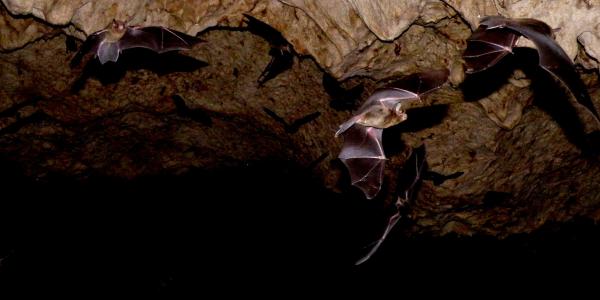To help determine forest restoration goals in Costa Rica, postdoctoral scholar Rachel Reid will travel to Central America this winter to explore a cave long inhabited by bats. The work is supported by WashU's Living Earth Collaborative.
What did the Costa Rican landscape look like thousands of years ago? A team of Saint Louis researchers is hoping that bat guano will help them answer that question.
Armed with peat borers and insect traps, a team of researchers led by Rachel Reid, a postdoctoral scholar in the Department of Anthropology, will travel to Central America this winter to explore a cave long inhabited by bats. The scientists plan to use biochemical signatures preserved in bat guano to understand how vegetation coverage has changed over the past several thousand years.

“One of the issues with forest restoration is this question of what do you restore to,” said Reid. “The tropics are tough in terms of finding longer-term records of climate and environment, largely because of preservation issues.” Heat and humidity take their toll on any type of signature that life might leave behind, Reid explained, making it difficult for researchers to reconstruct ancient landscapes using the types of rock deposits and preserved biomass often found in drier climates.
Instead, Reid’s team will look at biochemical signatures preserved in caves, which naturally shield their contents from much of the rainforest’s heat and humidity. Their field site, Bajo los Indios Cave, has housed a type of insect-eating bat known as Parnell’s mustached bat (Pteronotus parnellii) for millennia – which means the cave also has a cache of bat guano, the remains of insects digested by the bats, dating back thousands of years.
The chemical makeup of insects' exoskeletons is impacted by the vegetation they eat: If an insect eats corn, grass, or other open-habitat plants (which carry out photosynthesis via the C4 pathway), it will have a carbon isotopic signature that reflects C4 photosynthesis. If the insect eats rainforest vegetation (which uses the C3 photosynthesis pathway), its carbon isotopic signature will instead reflect C3 photosynthesis. And after a bat eats that insect, the same carbon isotopic signature will be preserved in the bat’s guano.
Reid’s team will use the peat borers – “They were designed to cut into peat bogs, and guano is similarly kind of soft,” she explained – to take vertical cores of the cave’s guano piles, essentially traveling thousands of years back in time through biochemical signatures preserved in the guano. Isotopic analyses and statistical modeling should allow her team to reconstruct the proportion of agricultural versus rainforest vegetation covering the Costa Rican landscape at any given time, Reid said.

Cave in Costa Rica (photo credit: J. Leighton Reid)
The team also plans to ground-truth their method using present-day insects and bat guano. They’ll use DNA metabarcoding, a technique that can provide a high-resolution snapshot of species diversity, to identify what insects currently make up the bats’ diet. Coupled with isotopic analyses of present-day insects and bat guano, the researchers should be able to determine proportionally the different insects that make up the bats’ diet.
“We know on the landscape today, corn is being grown, so we should be able to see some differences in C3 and C4 signatures in the different insects, depending on which vegetation they specialize on,” said Reid.
Reid's project is supported by a grant from the Living Earth Collaborative, a new center for biodiversity that brings together scientists from WashU, the Missouri Botanical Garden, and the St. Louis Zoo. The team also includes Bronwen Konecky, assistant professor of Earth and planetary sciences with expertise in paleoclimatology; Christy Edwards, a plant conservation geneticist at the Missouri Botanical Garden; J. Leighton Reid, an assistant scientist at the Garden with expertise in restoration ecology; and Xinyi Liu, an assistant professor of archaeology in the Department of Anthropology.





